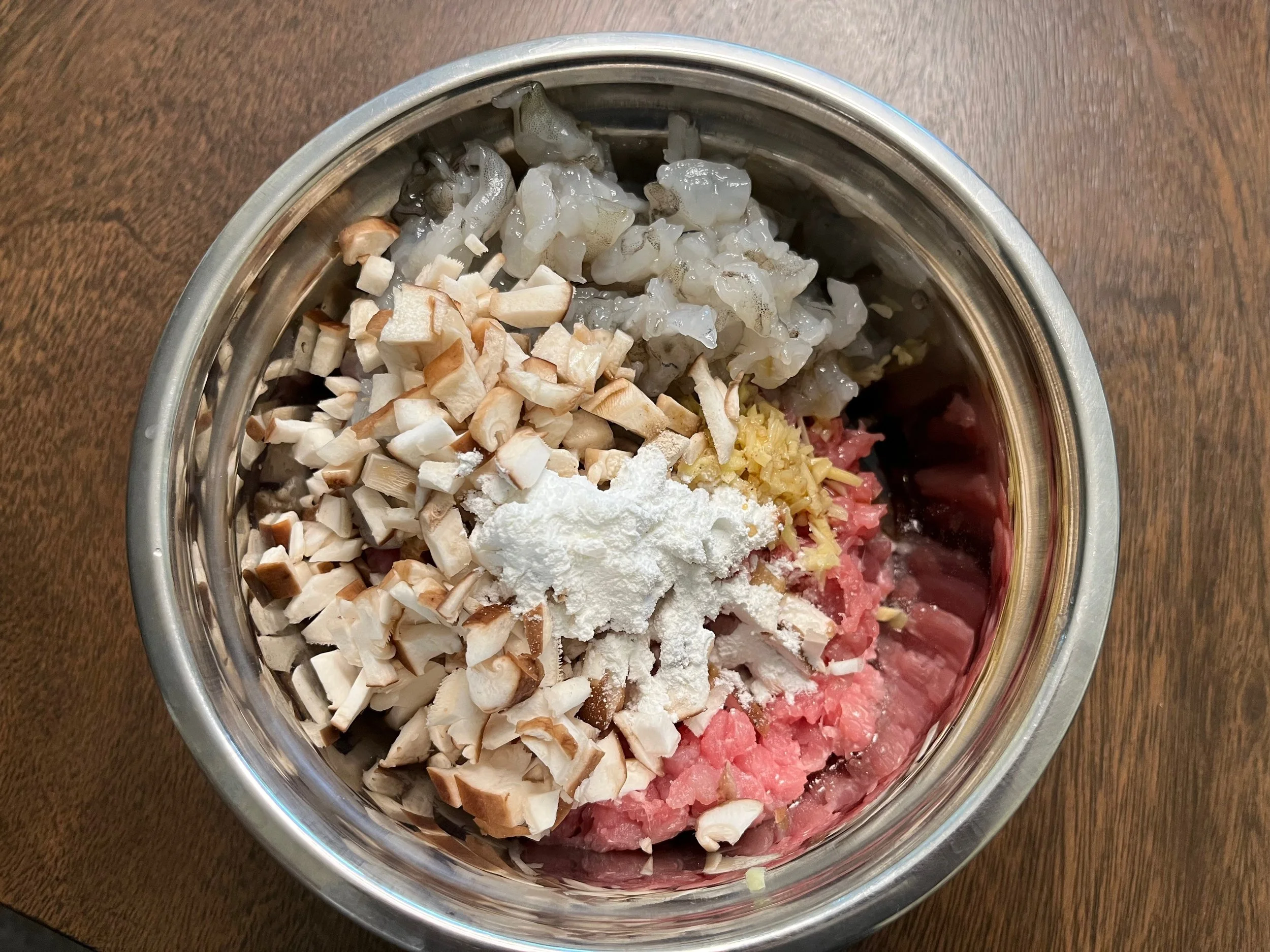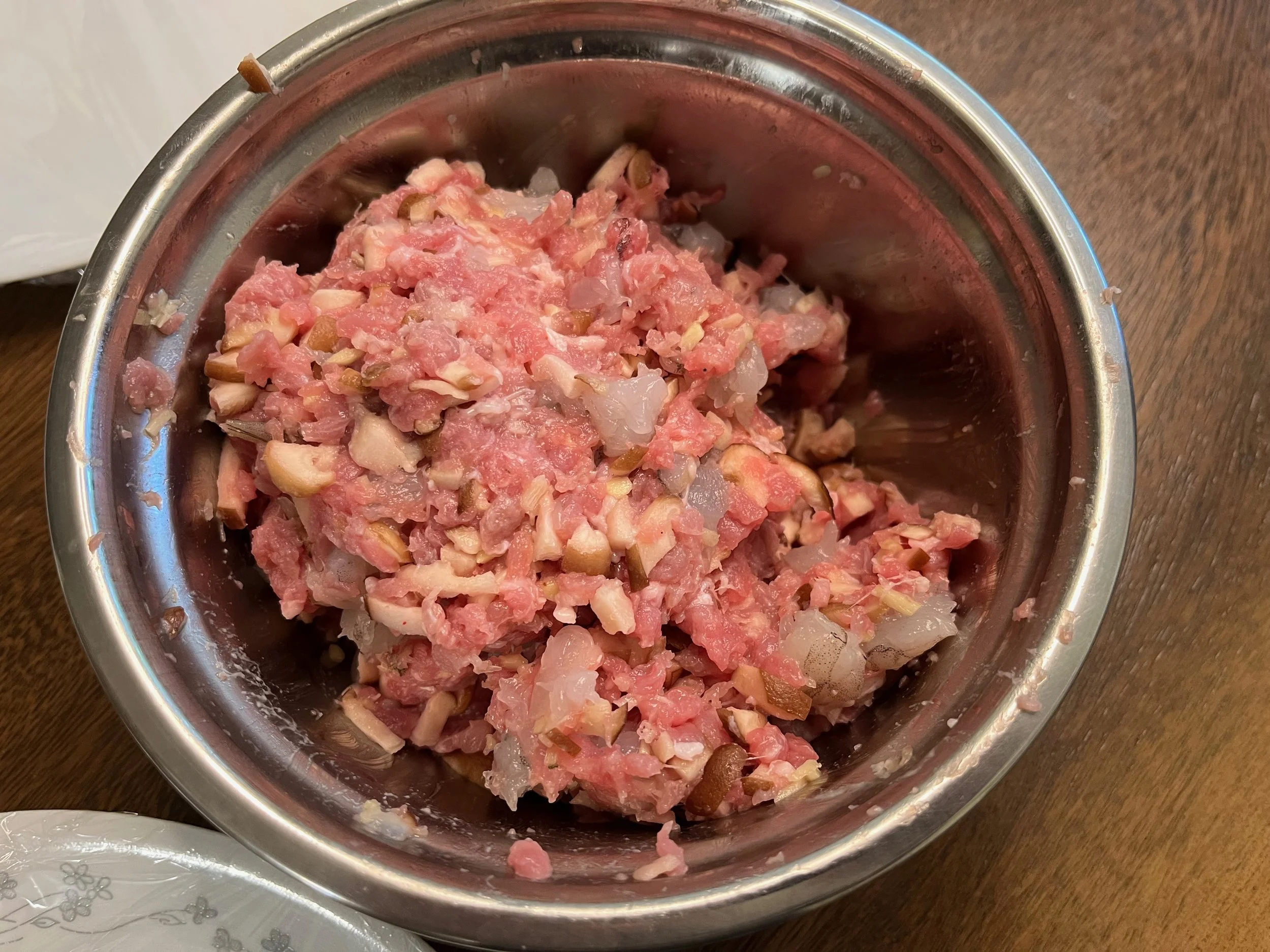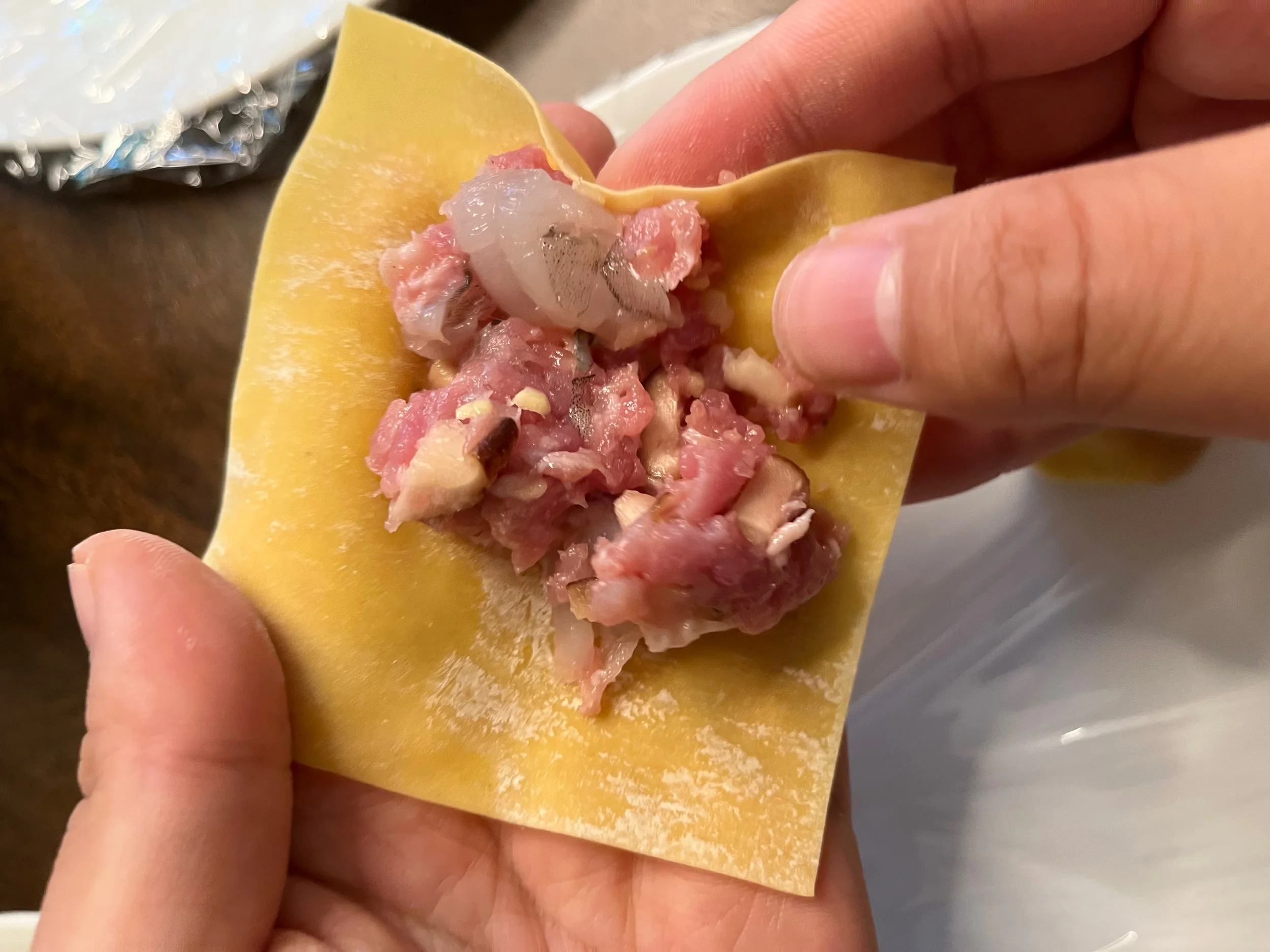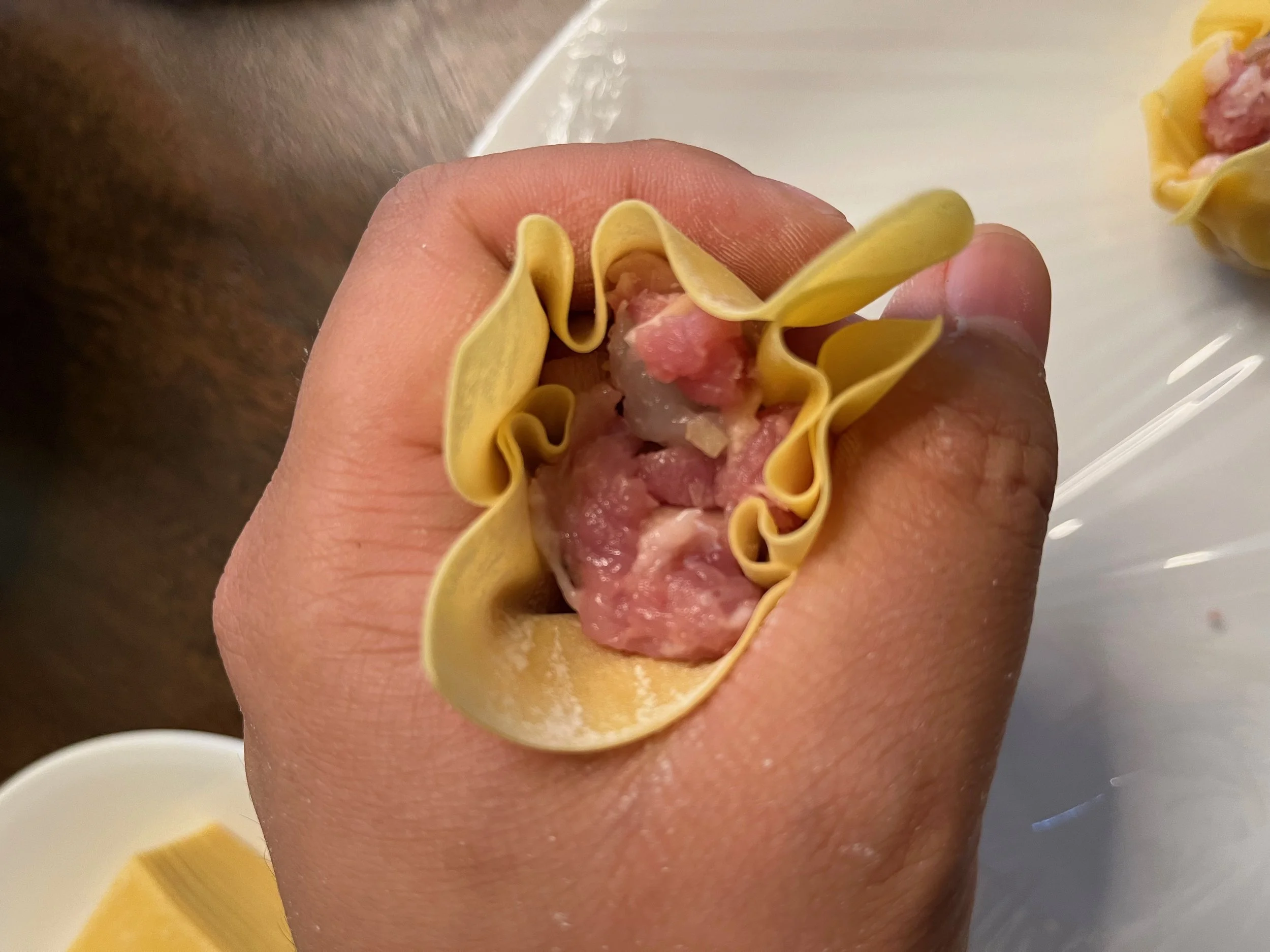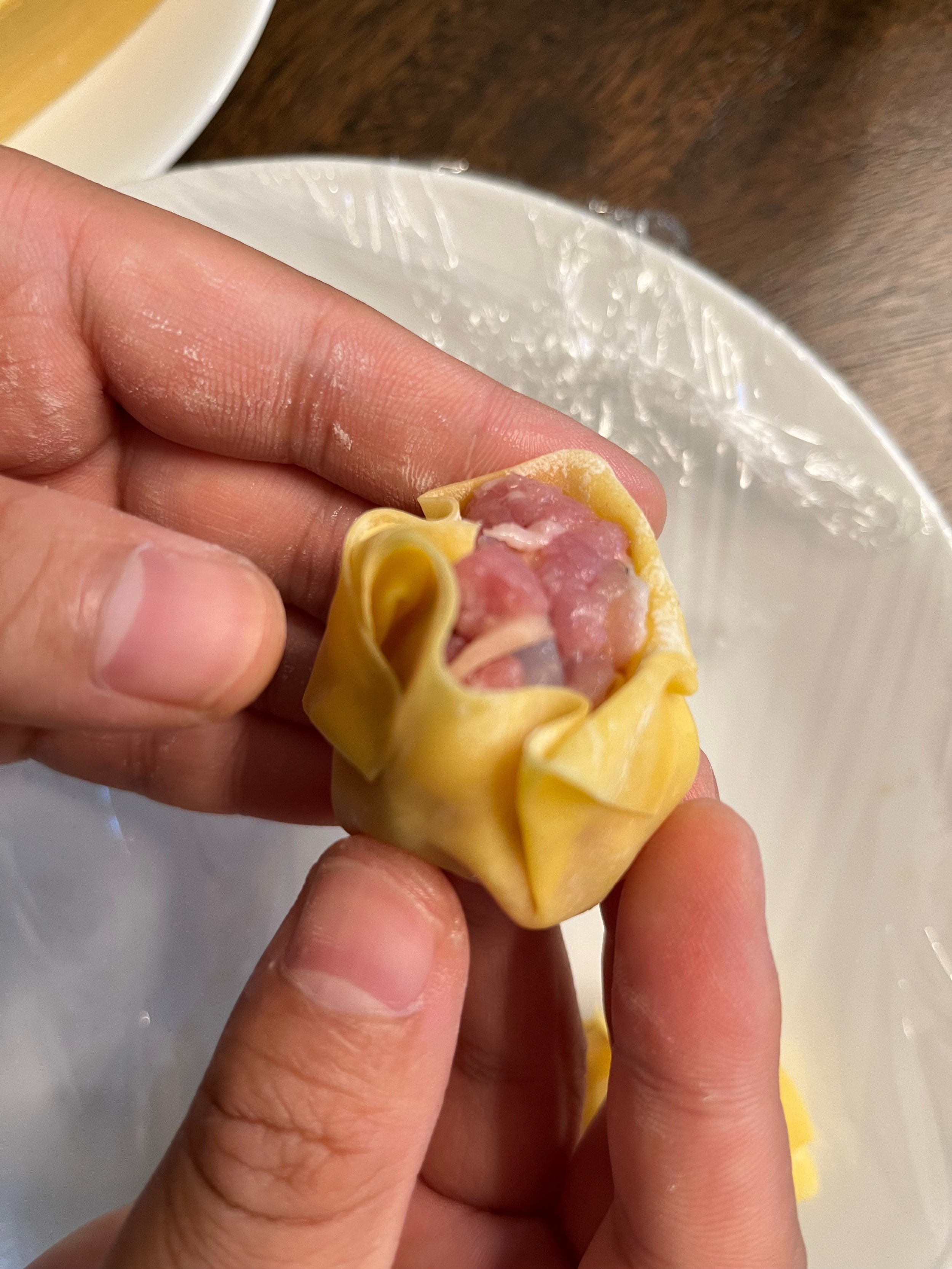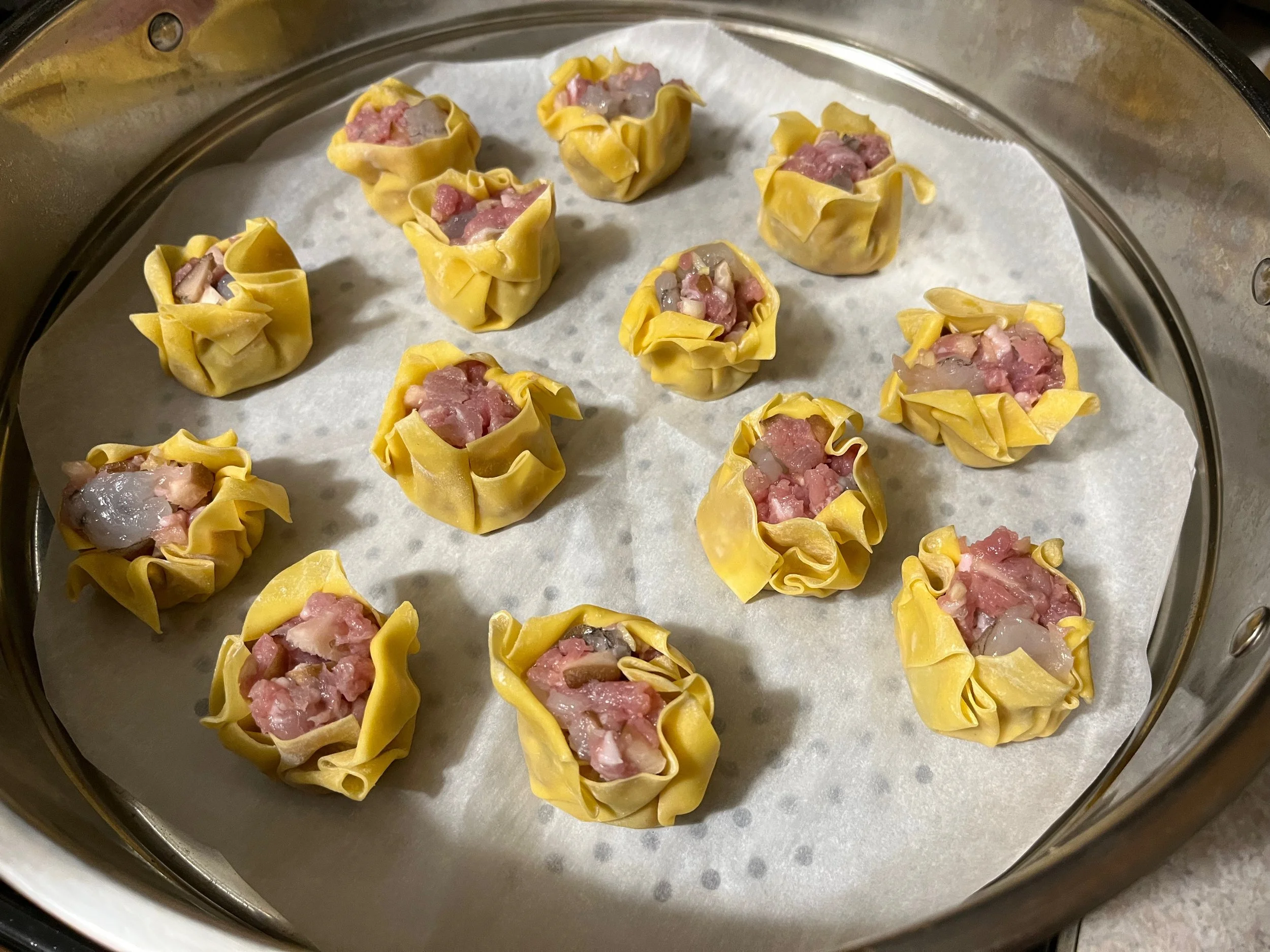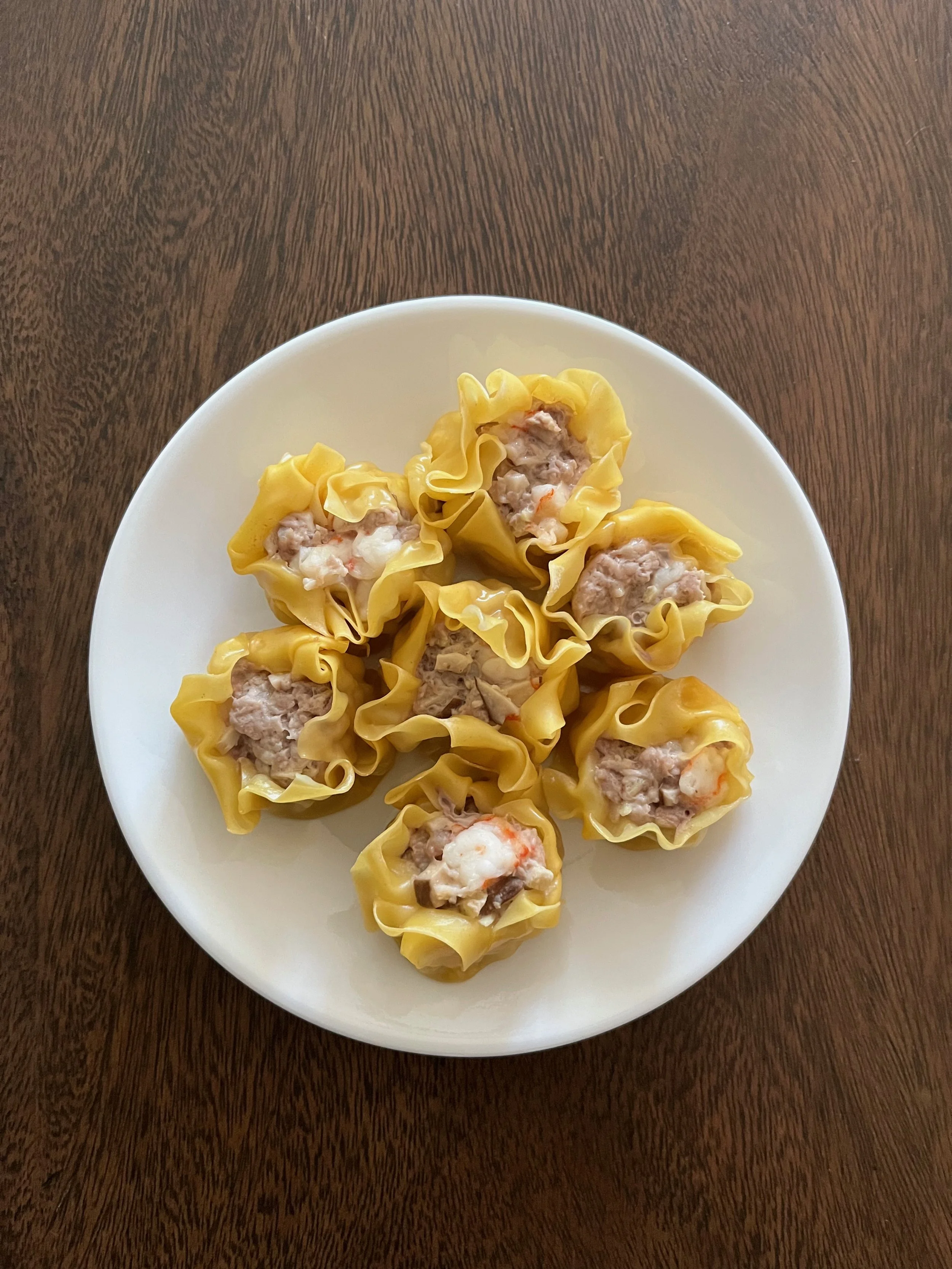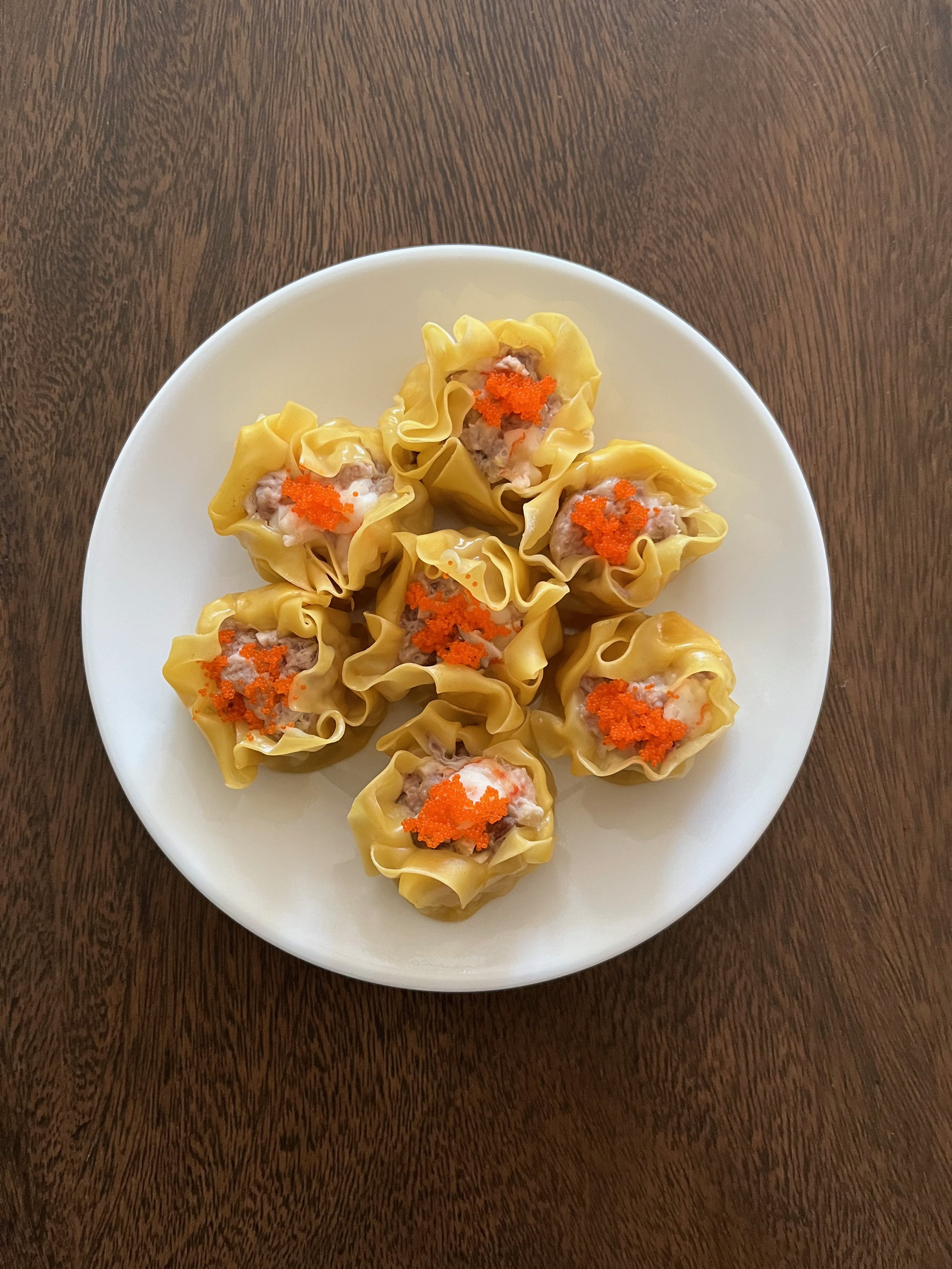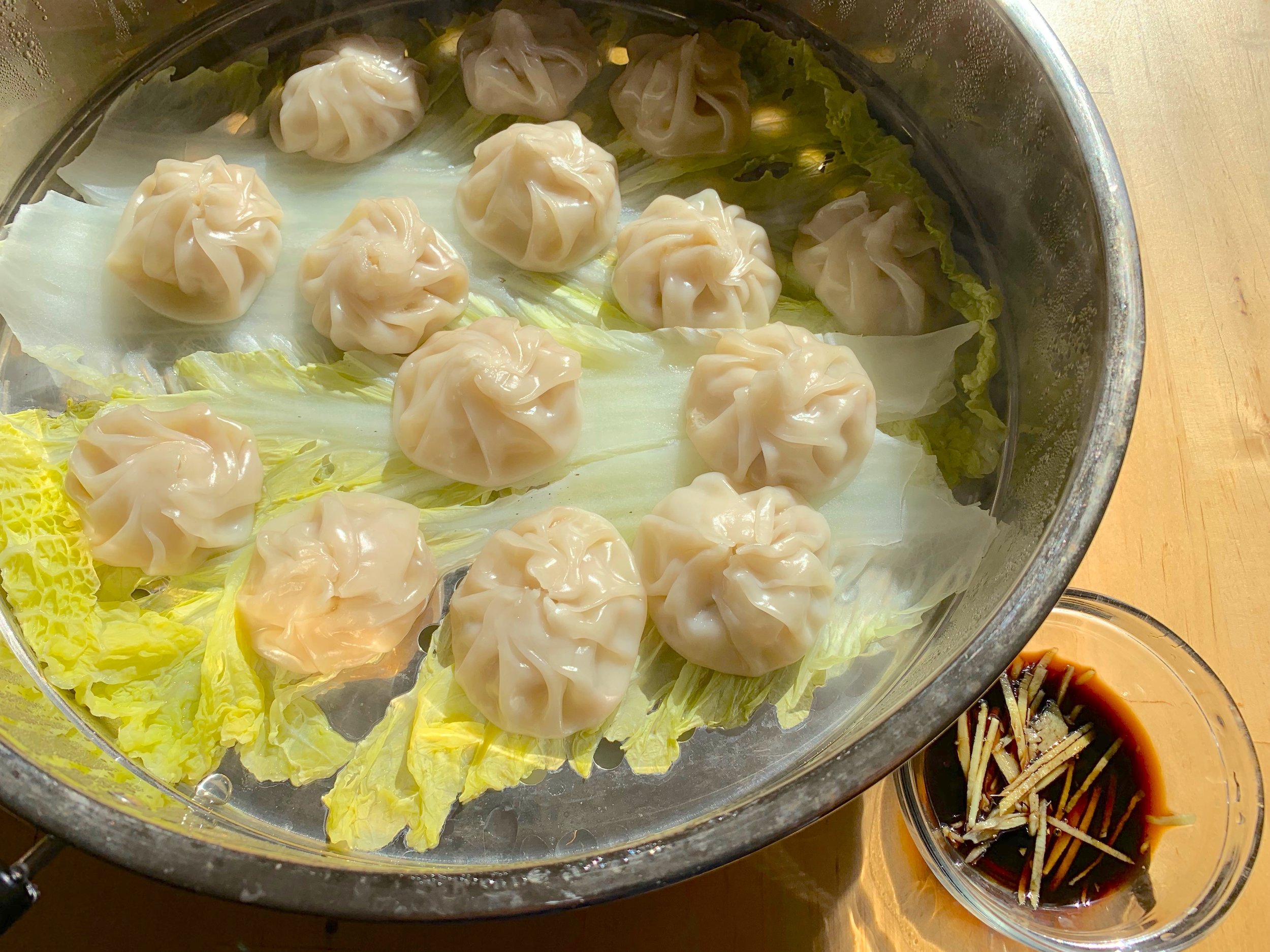Shumai
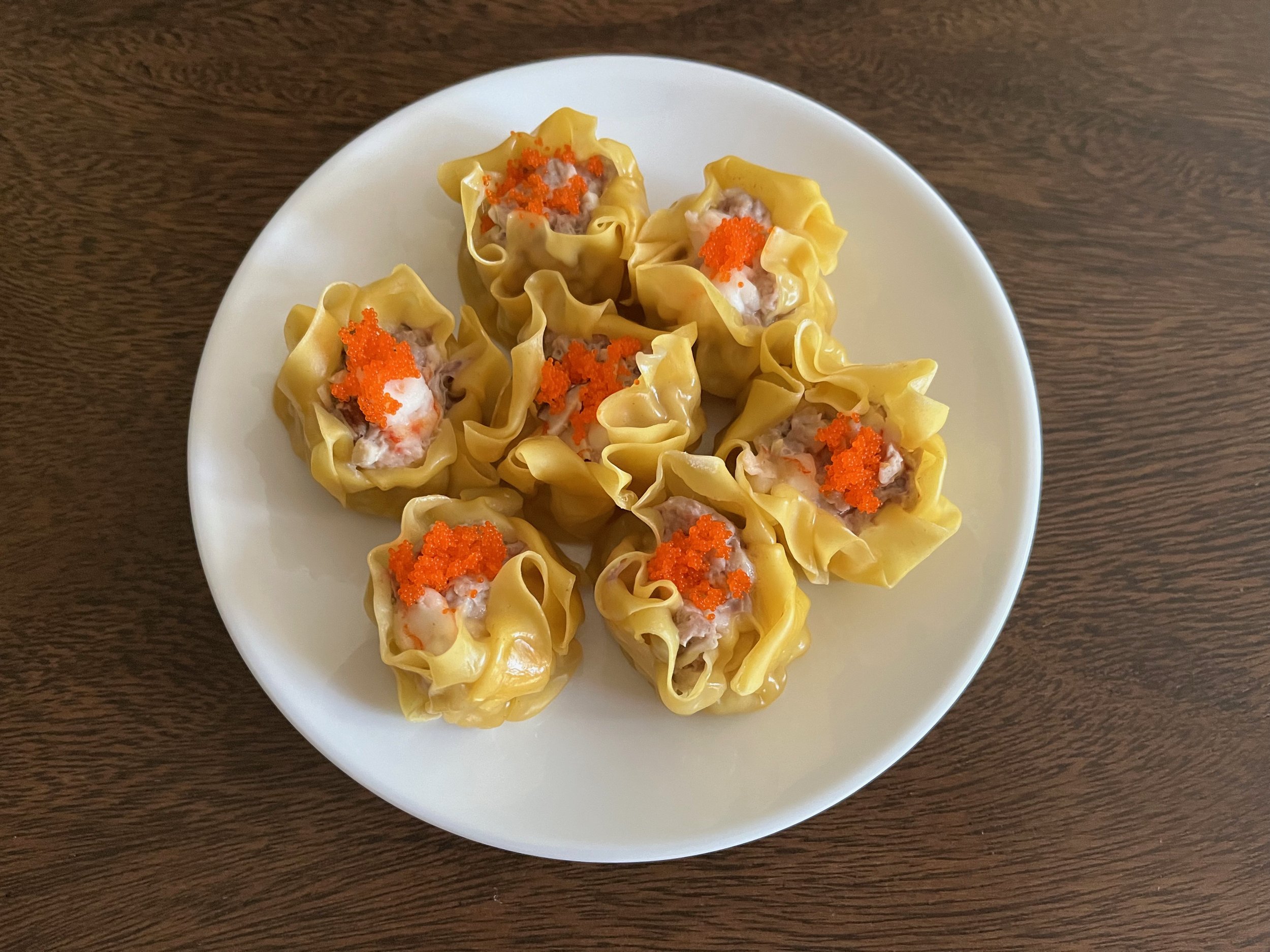
燒賣 (Siu Mai)
Cantonese shumai is a dim sum staple found in nearly every dim sum restaurant, a delicate steamed dumpling containing pork, mushrooms, and shrimp. Shumai is one of the simplest forms of Chinese dumpling. While the first surviving historical reference to shumai is from the Song Dynasty, many historians suspect that shumai is in fact several centuries older.[1] The first shumai were not of the now-ubiquitous Cantonese variety. Rather, shumai likely emerged in Inner Mongolia, where it was served in teahouses along the Silk Road.[2] This original version of shumai is made with mutton, flavored with ginger and scallion. The dumpling form gradually spread through China, and there now exist many regional variations and flavors of shumai. Today we will be tackling the dim sum classic, Cantonese shumai.
Ingredients
1 lb ground pork
⅓ lb shrimp
5 shiitake mushrooms
1 pkg wonton wrappers
1 inch ginger, minced
1 tbsp cornstarch
1 tbsp Shaoxing wine
2 tsp sesame oil
½ tsp white pepper
1 tsp salt
tobiko (optional)
Let us begin by preparing the filling, keeping in mind the two cardinal rules to constructing a dumpling filling: (1) the filling cannot contain too much water, (2) the ingredients must be finely chopped. Because mushrooms do not release as much water as leafy greens, we can simply finely dice the mushrooms. Also, because we will be steaming these dumplings, a gentler cooking method than boiling, we can afford to have slightly larger pieces. When mincing the shrimp for this recipe, I like to leave some of the shrimp in larger, 1 cm pieces, so you have recognizable pieces of shrimp in the cooked dumpling.
In a large bowl, combine the pork with the minced shrimp and diced mushrooms, together with salt, white pepper, cornstarch, Shaoxing rice wine, sesame oil, and finely minced ginger. The cornstarch will help bind the filling together, and absorb some of the moisture from the mushrooms. Mix well, using a large spoon or clean hands, until the mixture is homogeneous. No need to worry about over-mixing when it comes to dumpling fillings—cross-linking the proteins in the ground pork will actually help with structural integrity by binding the mushrooms and shrimp pieces tightly.
Check the filling for seasoning—the best way to do this is to take a small scoop of the filling and microwave it for 30 seconds or so, until it’s fully cooked. Adjust the seasoning to your taste, then prepare to wrap. You can prepare the filling up to two days in advance of wrapping if you wish. Cover tightly and store in the refrigerator.
Shumai have a very simple shape and are open at the top, making them one of the most forgiving types of dumplings to fold. We will be using wonton wrappers for shumai, which are thinner than dumpling and potsticker wrappers. You may find two kinds of wonton wrappers—yellow wrappers which contain egg in the dough (often labeled as “Hong Kong style”) and white wrappers which contain just flour and water. The yellow wrappers are preferred for shumai, but either form of wonton wrapper works.
On a clean table or counter, prepare a workspace for assembling the shumai. The wrappers, if frozen, should be fully thawed. It is important to stop the wrappers from drying out, so depending on how fast you can work, and how humid the air is, it is often a good idea to keep the wrappers covered before wrapping, either with plastic wrap or a clean tea towel. A towel is also useful for drying your fingers. Fetch a small bowl of cold water for sealing pieces of wrapper, and prepare a landing zone for the completed shumai. If you are planning on freezing the dumplings, prepare a plate, cutting board, or sheet pan covered in plastic wrap or parchment paper. The shumai should be placed in a single layer with a small amount of distance between them so they freeze individually.
Shumai are often garnished with an ingredient which will give the dumplings a splash of color. This is almost entirely for presentation, so feel free to skip the garnish. If you will be using a garnish, though, be sure to have it on hand when you start wrapping. Many restaurants will use tobiko, the small roe of flying fish, which can often be found in Japanese supermarkets.[3] You can also use salmon roe, finely minced carrot, or green peas.
To wrap, place a wonton wrapper in your palm, and scoop approximately 1 tablespoon of filling into the center of the wrapper. Cup your hand and gently squeeze, forming the wonton wrapper around the filling. Using your fingers, shape the dumpling into a rough cylinder shape. Dip a finger into the cold water and use it to smooth down the corners and pleats in the wrapper.
When you are done wrapping, if you intend on freezing the shumai, put your parchment or plastic wrap lined surface into the freezer. After 6 hours or so, the dumplings should be rock solid. Transfer into a zipper storage bag for storage in the freezer.
To Cook
Shumai are gently cooked in a steamer, and are too delicate to cook by any other means. If you own a steel or bamboo steamer, use it here! If you don’t own a dedicated steamer, however, it is fairly straightforward to hack together one. All you need is a pot large enough to fit a disposable pie tin. Punch some holes in the bottom of the pie tin to form an improvised steamer basket. Then, find something heatproof that you can perch the pie tin on, to keep it above water level. If you have metal cookie cutters or a clean can, use those. If not, you can ball up some aluminum foil to use as a stand.
Bring water to boil in the steamer. Meanwhile, line your steamer basket with parchment paper, and place the shumai in the basket. It is important to make sure that the shumai don’t stick, be sure to leave some distance between the dumplings. Once the water in the steamer reaches a boil, place the steamer basket on the heat and steam, covered, until the shumai are cooked through, approximately 6 minutes if the dumplings are fresh and 10-12 minutes if frozen. Top the filling with your garnish of choice, pressing it down slightly so it sticks to the filling. Serve hot, with soy sauce and chili garlic sauce available to dip into.
Substitutions
If you wish to make shumai without shrimp, simply substitute the shrimp for an equal amount of ground pork. Shumai also sometimes contains bamboo shoots or water chestnuts. To add these ingredients, finely dice them and add them to the filling mixture.
[1] The Song Dynasty reigned from 960-1279 CE.
[2] Some linguists believe that the name of this dish, siu mai (燒賣), is back-derived from a homonym, siu mai (捎卖), which translates to “sold on the side,” an indicator of its tea house origins.
[3] Traditionally, a small amount of crab roe was used, but crab roe is now hard to source and very expensive, and is rarely used for shumai in restaurants today.
Recipe
Prep Time: 1 hr Cook Time: 10 min Total Time: 1 hr 10 min
Difficulty: 3/5
Heat Sources: 1 burner
Equipment: steamer
Servings: 50 dumplings
Ingredients
1 lb ground pork
⅓ lb shrimp
5 shiitake mushrooms
1 pkg wonton wrappers
1 inch ginger, minced
1 tbsp cornstarch
1 tbsp Shaoxing wine
2 tsp sesame oil
½ tsp white pepper
1 tsp salt
Instructions
1. Finely dice the mushrooms and coarsely mince the shrimp. Add the ground pork, mushrooms, and shrimp to a large bowl.
2. Add to the salt, white pepper, cornstarch, rice wine, sesame oil, and minced ginger to the bowl, and mix well to form the filling.
3. To begin assembly, prepare a small bowl of water, and unwrap the wonton wrappers, keeping them under plastic wrap or a clean tea towel.
4. To wrap, place a single wrapper in your palm. Spoon about 1 tablespoon of filling into the center of the wrapper, then gently squeeze the corners of the wrapper against the filling, forming an open cylinder. Use a water-dampened finger to smooth down the corners and pleats of the wrapper.
5. Once all the shumai are wrapped, cook immediately, or freeze.
To Cook
1. Line a steamer basket with parchment paper and place the shumai in the basket, leaving space between the dumplings. Bring water in the steamer to a boil.
2. Steam until fully cooked—about 6 minutes fresh or 10-12 minutes frozen.


